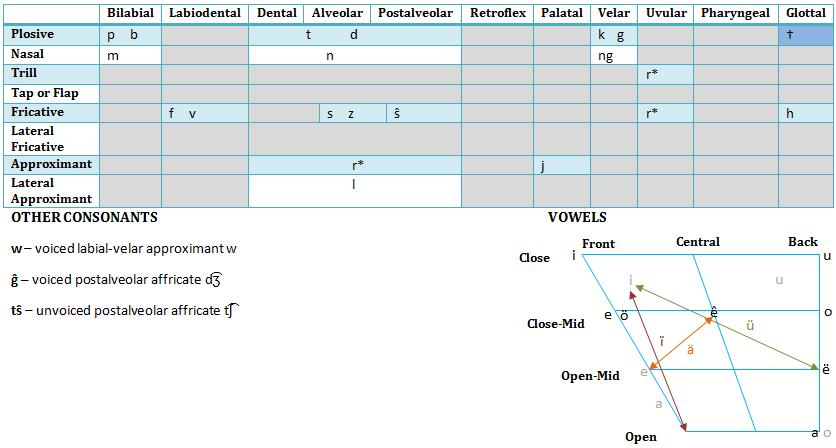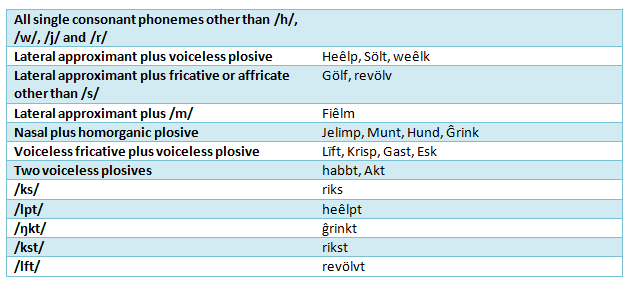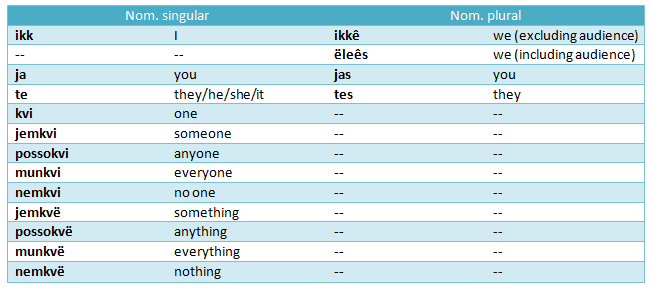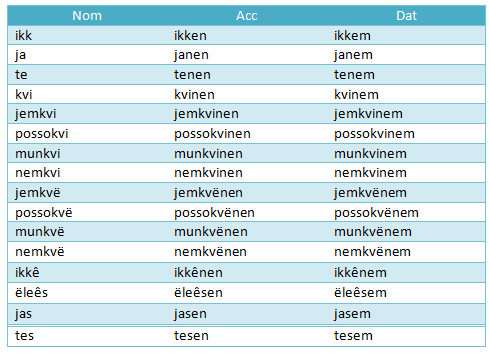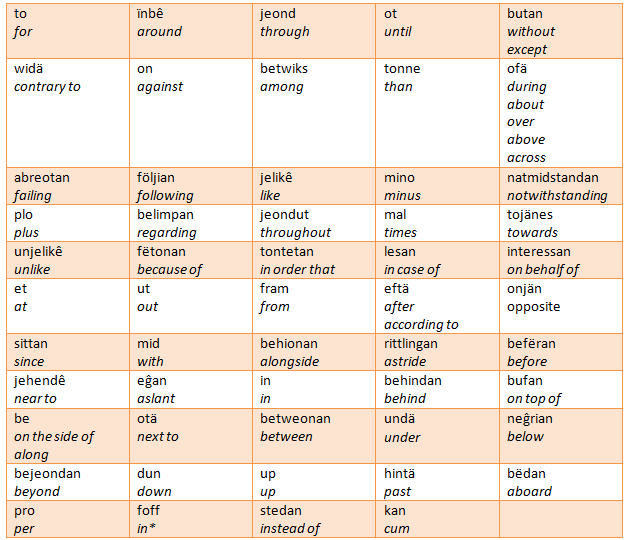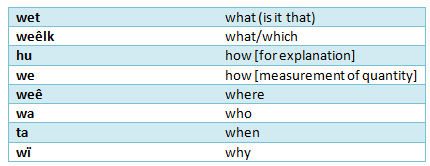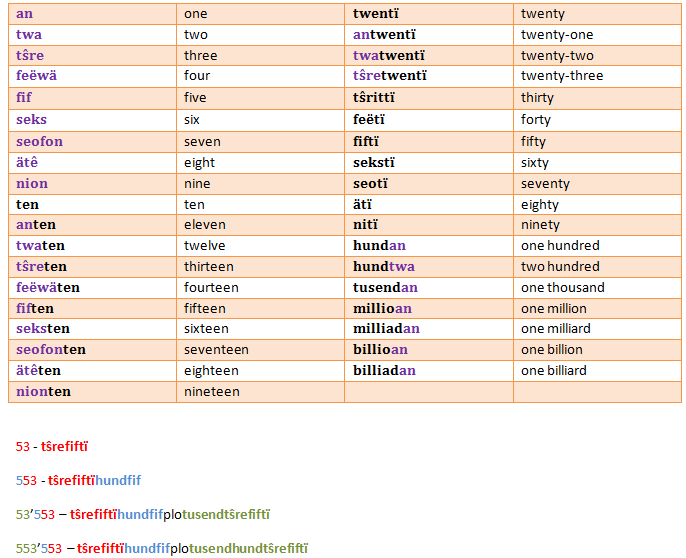Tauro-Piscean language
| Lingvo täropiskes'um | |
|---|---|
| Pronounced: | [liːŋgvoː teəɹoːpiːskeːsuːm] |
| Timeline and Universe: | Present, parallel Earth |
| Species: | Human |
| Spoken: | Democratic People's Republic of New Pisces and Taurus |
| Total speakers: | ~2,000,000 |
| Writing system: | Latin alphabet |
| Genealogy: | Indo-European Germanic |
| Typology | |
| Morphological type: | Inflecting |
| Morphosyntactic alignment: | Nominative-accusative |
| Basic word order: | V2 |
| Credits | |
| Creator: | S.C. Anderson, L.J. Partridge |
| Created: | 27 November 2007 |
The Tauro-Piscean language is a West Germanic language and principally a descendant of Old English. It is spoken by approximately two million native speakers in the Tauro-Piscean Republic. It stands out from other Germanic languages due to its lack of purely grammatical gender - despite retaining this feature in a significant form - its peculiar tense system and inflection, its large number of moods, the amount of vocabulary borrowed from Romance languages and Old Taurusian, and, to some degree, its phonology.
Contents
Phonology
- The uvular trill, uvular fricative and alveolar approximant are in free variation with one another.
- Glottal stops are present between a word that ends in a vowel and the next word when it begins with a vowel.
- The black vowels are the dominant forms, whereas the grey vowels are recessive and only pronounced in such a manner when they are followed by two like consonants, e.g. bb, dd, ff, etc.
- The multicoloured umlaut vowels are pronounced as diphthongs, where the arrows represent the glides.
ä = /eə/
ï = /aɪ/
ü = /ɔɪ/
Phonotactics
Syllable structure
The syllable structure in Tauro-Piscean is (C)(C)(C)V(V)(C)(C)(C). Thus, every syllable must contain at least one vowel.
Onset
The following can occur as the onset:
Coda
The following can occur as the coda:
Syllable-level rules
- Both the onset and coda are optional
- /l/ as a coda may only be preceded by a, ê and ö. /lp/, /lt/, /lk/, /lf/, /lv/ and /lm/ as a coda may only be preceded by ö.
Stress
Stress in Tauro-Piscean usually falls on the first syllable, with the following exceptions:
- Verbs of the -eêran group (applicable to all inflections, e.g. -eê, -eêrong, etc.) receive stress on their penultimate syllable.
- Similarly, nouns of the -eêrung group receive stress on their penultimate syllable.
- Nouns ending in -izmo also receive stress on their penultimate syllable.
- Adjectives of the -abêl, -ibêl, -itis, -ozê and -ezê groups receive stress on the first syllable of the suffix.
- Words that begin with the prefixes be-, ge-, ent-, ä-, är- vä-, vär-, zä-, zär-, miss-, äf-, äs-, a-, ond-, bi-, fë-, je-, on-, to-, un-, ïm-, of- and et- receive stress on the syllable that follows the prefix.
- Nouns ending in -ion, -ä and -io receive stress on the syllable that precedes the suffix.
- Nouns ending in -uê receive stress on the penultimate syllable.
- Prefixes and suffixes associated with grammatical tense and mood are never stressed; the verb stem is always that which receives stress. For example, in 'gekumut', 'kum' - which is the stem of 'kuman' ('to come') - is the syllable that is stressed.
- Words in which a vowel is marked with an acute or grave accent receive stress on the indicated syllable (in which the marked vowel is contained). (Note that a grave-accent-marked vowel is a combination of an umlaut vowel and a acute-accent-marked vowel. Therefore, the grave accent affects pronunciation in addition to stress.)
Intonation
Prosodic stress is extra stress given to words when they appear in certain positions in an utterance, or when they receive special emphasis. It can shift for various pragmatic functions, such as focus or contrast.
- Best Mäjenenwist tomäjen? - Is it breakfast tomorrow?
- Nesê, ne Ĕfenenwist tomäjen - no, it's dinner tomorrow
- Ikk rekk nat„ wet smä jă - I don't care what you think
- Ikk kwetedê„ dass hāb ikk twa Hundênen - I said that I would have two dogs
Often indicated in English using italic letters, it is indicated in Tauro-Piscean by replacing the first vowel of the stressed word with its breve or macron form, depending on whether the vowel is plain or umlaut respectively.
Orthography
The Tauro-Piscean alphabet is a variant of the Latin alphabet, using the following letters:
A B D E F G H I J K L M N O P R S T U V W Z Ĝ Ŝ Ä Ë Ï Ö Ü Ê
(Vowels with acute, grave, macron and breve accents are not considered part of the alphabet because they affect only stress: Á É Í Ó Ú À È Ì Ò Ù Ă Ĕ Ĭ Ŏ Ŭ Ā Ē Ī Ō Ū)
Tauro-Piscean orthography is highly phonemic and graphemes correspond accurately to phonemes.
In some cases, silent letters are present or the usual grapheme to which a phoneme corresponds is changed, namely when verbs are inflected for the present perfect and past continuous tenses (when T is added to the stem of the verb):
- The value of B becomes /p/ e.g. habb /hæb/ becomes habbt /hæpt
- D becomes silent, e.g. hïd /haıd/ becomes hïdt /haıt/
- The value of G becomes /k/ e.g. zag /zɑ:g/ becomes zagt /zɑ:kt/
- The value of V becomes /f/ e.g. revölv /re:vø:lv/ becomes revölvt /re:vø:lft/
- The value of Z becomes /s/ e.g. rïz /raız/ becomes rïzt /raıst/
Dominant vowels - apart from Ê - are always long, while recessive vowels (followed by two like consonants) and Ê are always short.
Two like consonants are pronounced in the same manner as one of those consonants alone, but the pronunciation of the vowel preceding the consonants is altered (from dominant to recessive).
Loanwords from other languages are adapted for Tauro-Piscean orthography and pronunciation. In many cases, the new variants become unrecognisable from the original word, but consistent spelling is retained. For example, the Tauro-Piscean word 'Seĝuê' ('weekend') /se:ʤu:ə/ is adapted from the French word 'séjour' ('stay', 'sojourn', 'abode') and 'Feton' ('soap opera') /fe:to:n/ from the French 'feuilleton'.
Anderson plans to develop an enhanced version of the Tauro-Piscean orthography as an alternative to IPA for transliterating words.
Nouns
The initial letter of every noun in Tauro-Piscean is capitalised.
Like most Germanic languages, Tauro-Piscean forms left-branching noun compounds, where the first noun modifies the category given by the second. For example: Hundenhuttê (dog hut or doghouse). Unlike English, where newer compounds or combinations of longer nouns are often written in open form with separating spaces, Piscean always uses the closed form without spaces. For example: Tŝreënhus (tree house).
Tauro-Piscean compounds also assist in the differentiation of a compound adjective from two adjacent adjectives that each independently modify the noun. Compare the following examples:
- Essïzëren Zürênlözung - acid solution that is acetic > acetic acid solution
- Essïzëren Zürê Lözung - solution of acetic acid > acetic-acid solution
- Runden Beod Redung - discussion held at the round table > round-table discussion
- Runden Beodenredung - table discussion that is round > round table discussion (note that this does not make sense)
When forming a compound of two words, -n must be added to the end of the first word if it ends in a vowel, or -en if it ends in a consonant.
Genders
The Piscean language includes three 'logical' grammatical genders. While in many languages, the genders do not often relate to biological gender of nouns, they do in Tauro-Piscean; therefore, most nouns are neuter, while creatures of the male sex are masculine and creatures of female sex are feminine. If one refers to a creature, but does not wish to distinguish sex, the neuter gender can be used as a substitute. Observe the following examples:
- tet Sunnê - the sun (no sex, so neuter)
- tet Mann - the person (no sex specified, so neuter)
- sê Mann - the man (male, so masculine)
- seo Mann - the woman (female, so feminine)
The above example shows the importance the article plays in Piscean of distinguishing between sexes in a language where one noun fits all.
Articles
Definite articles
Indefinite articles
Demonstrative articles
Tauro-Piscean makes a two-way distinction between the demonstratives, the proximal of which is formed by using the appropriate definite article plus the word 'heonan'.
- Tet heonan Tŝramet - this page
- Ikk red ten heonan Bok - I read this book
The distal is formed using the appropriate definite article plus the word 'tonan'.
- Tet tonan Tŝramet - that page
- Ikk red ten tonan Bok - I read that book
Singular and Plural
There are several ways to form plural nouns in Tauro-Piscean:
- Bok > Bokê (add –ê to nouns that end in a consonant)
- Äto > Ätos (add –s to nouns that end in a vowel other than ê)
- Sunnê > Sunnên (add –n to nouns that end in ê)
Cases
Tauro-Piscean implements five cases: nominative, accusative, dative, genitive and instrumental.
Nominative case
This case is used for the subject of the sentence (i.e. the noun doing the verb) and as a complement after: 'bean' ('to be'), 'weëtan' ('to become') and 'hatan' ('to be called').
- Tet Äto be niwê - the car is new
- Tet Hund bit - the dog bites
Accusative case
This case is used for the direct object (i.e. the noun having the verb done to it/them) and after certain prepositions.
- Ikkê bïĝ ten Äto - we buy the car
- Ikk et ten Banánê - I eat the banana
When there is no article with the noun, the noun itself must be inflected. To do so with a noun that ends in a consonant, add -en - or, if it is a proper noun, add -'en. If the noun or proper noun ends in a vowel, add -nen or -'nen respectively.
- Infëmaksion - information
- Ikk habb Infëmaksionen - I have information
Note that when inflecting a plural noun, it must be made plural before it is inflected for the accusative (the same applies to the dative, genitive and instrumental cases).
- Äto - car
- Ätos - cars
- Ikk mag Ätosen - I like cars
The accusative case allows for flexible sentence structure that can place emphasis on a certain word by changing its location, yet retaining original meaning. For example:
- Se Hund bit sen Mann - The dog bites the man
- Sen Mann bit se Hund - The dog bites the man
Both of the above Tauro-Piscean sentences have the same translation into English. On first glance, an English speaker might confuse the second example as 'the man bites the dog', although this is because the object comes before the subject. Because the word 'Mann' is preceded by the accusative article and 'Hund', by the nominative, those skilled in Tauro-Piscean can easily deduce the sentence's meaning. Meanwhile, the first example places emphasis on the subject, while the second places greater emphasis on the object.
Dative case
This case is used for the indirect object (i.e. the noun receiving or being given/sent/lent something) and after certain prepositions. This also translates the English word 'to' when it precedes a noun.
- Ikk jef tenen sem Lerärê - I give it to the teacher
The dative case is used when referring to travel:
- Ikk fa tem Sköl - I go to the school
To inflect a noun ending in a consonant when there is no article, add -em, or -'em for a proper noun. For a noun ending in a vowel, add -nem, or -'nem for a proper noun.
- Ikk fa Lunden'em - I go to London
Genitive case
This case is used to denote possession or ownership. 'The man's car' translates literally as 'the car of the man', but with the genitive case translating 'of' (instead of a separate word).
- Tet Äto ses Mann - the man's car (the car of the man)
To inflect a noun ending in a consonant when there is no article, add -es, or -'es for a proper noun. For a noun ending in a vowel, add -nes, or -'nes for a proper noun.
- Tet Rum Sean'es - Sean's room (the room of Sean)
- Tet Abït Gaynor'es - Gaynor's job (the job of Gaynor)
The case is also used as the genitive partitive.
- An Stïkê Kïsênes - a piece of cheese
- An Gruppê sis Mannê - a group of men
Instrumental case
The first use of the instrumental case is to replace words such as 'with' and 'by' in English in the context that they mean 'by means of' - in other words, to indicate that the noun in question is an 'instrument'.
- Tet Bän - the train
- Ikk fa bänum - I go (by) train
- Ikk fa temum bän - I go (by) the train
- Tet Kuli - the pen
- Ikk rit kulinum - I write (with a) pen
- Ikk rit temum kuli - I write (with) the pen
Despite the rule in Tauro-Piscean that all nouns begin with a capital letter, when in the instrumental case, this capital is dropped.
The second use of the instrumental case is to denote nationality.
- Englas - England
- Ikk zï englas'um - I am English (literally - 'I am by means of England')
To inflect a noun ending in a consonant when there is no article, add -um, or -'um for a proper noun. For a noun ending in a vowel, add -num, or -'num for a proper noun.
Adjectives
Adjective Endings
In English, an adjective can appear in one of two different places in a sentence:
- Separated from the noun it describes: the tree is small
- Immediately before the noun it describes: the small tree
The same phrases in Tauro-Piscean are:
- Tet Tŝreë zï smalê - the tree is small
- Tet smalên Tŝreë - the small tree
Notice that when the adjective appears ammediately in front of the noun it describes, it must be inflected. The endings depend on whether the adjective's final letter is a vowel or a consonant.
For one that describes a neuter noun, whose final letter is a vowel, add -n and for one whose final letter is a consonant, add -en.
For one that describes a masculine noun, whose final letter is a vowel, add -het and for one whose final letter is a consonant, add -et.
For one that describes a feminine noun, whose final letter is a vowel, add -heo and for one whose final letter is a consonant, add -eo.
Possessive Adjectives
Possessive adjectives are translated using genitive-derived variants of pronouns. In Tauro-Piscean, they always follow the noun. Additionally, the definite article is used.
- Tet Bok ikkes - my book
- Tet Hus janes - your house
Comparative and Superlative Adjectives
Comparative adjectives
One uses these to compare things, for example when you're saying something is smaller than something else.
- smalê (small) > smalêjä (smaller)
Whereas English sometimes uses 'more' and 'less' instead of '-er', Tauro-Piscean follows regular patterns.
- intäressant - interesting
- more .../...er > ...ä (more interesting > intäressantä)
To say 'more ...', one simply adds -ä to an adjective that ends in a consonant, or -jä to an adjective that ends in a vowel.
- intäressant > intäressantä (interesting > more interesting)
To say 'less ...', one adds -ë to an adjective that ends in a consonat, or -jë to an adjective that ends in a vowel.
- intäressant > intäressantë (interesting > less interesting)
To say 'less/more interesting than ...', use 'tonnê' and the accusative case afterwards.
- An Bok zï intäressantä tonnê anen Fiêlm - a book is more interesting than a film
- An Bok zï intäressantë tonnê anen Fiêlm - a book is less interesting than a film
Superlative adjectives
Superlative adjectives are used to say something is the best, tallest, etc.
- jod (good) > jodü (best)
To say 'most ...', one adds -ü to an adjective that ends in a consonant, or -jü to an adjective that ends in a vowel.
- intäressant > intäressantü (interesting > most interesting)
To say 'least ...', one adds -uš to an adjective that ends in a consonant, or -š to an adjective that ends in a vowel.
- intäressant > intäressantuš
Comparative and superlative adjective endings
As with normal adjectives, comparatives and superlatives must have an ending if they appear directly in front of a noun they are describing.
- Tet Bok zï intäressantä - the book is more interesting
- Tet intäressantän Bok - the more interesting book
Adverbs
Adverbs describe or give more information about verbs. In Tauro-Piscean, they are the same as adjectives.
- Tet Äto be sneêl - the car is quick
- Tet Äto fa sneêl - the car goes quickly
Pronouns
Direct and Indirect Object Pronouns
Like nouns, pronouns change according to the case. Here is the full ist of pronouns in the nominative, accusative and dative cases.
- Ikk mag tenen nat - I don't like them
- Te mag ikken nat - they don't like me
- Ja send ikkem anen Jefu - you send [to] me a present
- Ikk send janem anen Jefu - I send [to] you a present
Relative Pronouns
Relative clauses begin with relative pronouns: words that correspond to 'who', 'whom', 'that' and 'which' in English. These may be omitted in English, but must be included in Tauro-Piscean. A comma always precedes the relative pronoun, which is put into the correct gender depending on the noun it refers to (the same as the definite articles), and the correct case depending on its function in the clause. (In the following example, the relative pronoun is in the masculine accusative case because 'Manteêl' is masculine, and is a direct object of the verb 'to buy'; therefore, it is accusative.)
- Te zï tet Manteêl, ten bïĝedê ikk jestŝran - that is the coat [that] I bought yesterday
- Seo Hund, seon sedê ikk et endenesten Wiku - the bitch [that] I saw last week
- Te be sê Mann, sem kwetedê ikk nemkvënen - he is the man to whom I said nothing
Verbs
Moods and Tenses
Infinitive mood
Using the infinitive unchanged translates the word 'to' in addition to the verb.
- Ikk mag plean - I like to play
In their widely known form, Tauro-Piscean verbs end in -an, -ran, -ian, -rian, -wian or -jian.
This needs to be changed according to grammatical mood and tense. There is no conjugation depending on grammatical person in the Tauro-Piscean language.
Imperative mood
Imperative verbs express direct commands, requests and prohibitions. The imperative is formed with an infinitive verb in conjunction with a VSO (verb-subject-object) word order.
- Redan ten Bok - read the book
- Skäwian ten heonan Tramet - see this page
Indicative mood
The indicative mood is the most common in the Piscean language, used for factual statements and positive beliefs. It is normally formed in the present simple tense by removing the infinitive ending.
- Ikk red ten Bok - I read the book
- Ja skä ten heonan Tramet - you observe this page
The mood is compatible with other tenses, in which cases the infinitive must be altered differently.
To form:
Present simple - if the infinitive ending is -an, -ran, -rian, -wian or -jian, remove it. If it is -ian, change it to -ê
Present continuous - remove the significant part of the infinitive ending (i.e. the -an or the -ian, but not the R, W or J that may come before those letters). Then, add -ong if the stem ends in a consonant, or -ng if it ends in a vowel.
Present perfect - the word 'nef' must be placed before the variant verb, which is formed as in present simple, but with an additional T.
Preterite - formed as in present continuous, but with -edê (after a consonant) and -dê (after a vowel) substitued for -ong and -ng respectively.
Imperfect - formed as in present continuous, but with -ot (after a consonant) and -jot (after a vowel) substituted for -ong and -ng respectively.
Past continuous - formed as in present perfect, but with the word 'wüz' in place of 'nef'.
Pluperfect - formed as in imperfect, but with -ut and -jut substituted for -ot and -jot respectively; additionally, ge- must be prefixed onto the verb if it begins with a consonant, or g- if it begins with a vowel.
Future - formed with the infinitve. The word 'will' must be placed before the verb.
Future perfect - formed as in pluperfect, but with -in and -jin substituted for -ut and -jut respectively - and ez- substituted for both ge- and g-.
Interrogative mood
Verbs in inflected in this manner if they are used to ask questions. The interrogative mood not normally used with a noun or pronoun, but if context does not make this clear, a noun or pronoun can be included after the interrogative verb (VSO word order).
- Habbest anen Kuli? - do you have a pen?
In every tense, the interrogative is formed as in the indicative, save for adding -est to the verb if its final letter is a consonant, or -st if its final letter is Ê and with the future being an exception to this rule.
In the future, the word 'will' (modal verb 'willan') must be inflected by adding -est. Additionally, whichever verb is in question - in the case of the table 'faran' - is inverted to the end of the sentence.
- Willest anen Kuli habban? - will you have a pen?
Conditional mood
The conditional mood is used to speak of an event whose realisation is dependent on a certain condition.
- Ikk häb anen Kuli - I would have a pen
The conditional present simple, present continuous and present perfect tenses are formed as in indicative, but with the first vowel in the verb taking an umlaut. If the stem of the verb ends in a double consonant (same letter), this must be reduced to just one. For example:
- Ikk habb (indicative) > Ikk häb (conditional)
Ta
The Tauro-Piscean word 'ta' can mean both 'if' and 'when'. It means 'when' when it is followed by a verb in the indicative mood.
- Ta habb ikk jenün Feë - when I have enough money
It means 'if' when it is followed by a verb in the conditional mood.
- Ta häb ikk jenün Feë - if I have enough money
Jussive mood
The jussive mood in Tauro-Piscean is used to express plea, insistence, imploring, self-encouragement, wish and desire.
- Se Hund wïêl bït - the dog should bite
It is formed in the same way as conditional, but with the word 'wïêl' before the verb in question, or before the word 'nef' if it is present.
Dubitative mood
The dubitative mood expresses the speaker's doubt, uncertainty or speculation about the event denoted by the verb. Tauro-Piscean implements two variants of the dubitative mood, one of which is known as 'presumptive' and the other as 'assumptive'.
- Te bedog in California'nem - They must be in California (assumptive - what is perceived to be the probable event)
- Te bëdog in California'nem - They might be in California (presumptive - what is perceived to be a possible event)
The assumptive is formed similarly to the interrogative mood, but with the -dog suffix substituted for -est.
The presumptive is formed as the assumptive, but with an umlaut on the first vowel of the verb stem and 'wïêldog' instead of 'willdog' for the future.
Modal Verbs
Modal verbs give additional information about the mood of the main verb that follows it.
- Mean - to be allowed to
- Kunnan - to be able to
- Magan - to like
- Skölan - to have to
- Zollan - to be supposed to
- Wölan - to want to
- Willan - will
The other verb that is used with the modal is always in the infinitive form and at the end of a clause.
- Ikk kunn tem Fotenpuffenspeêl faran - I can go to the football match
- Ikk wöl tem Fotenpuffenspeêl faran - I want to go to the football match
Reflexive Verbs
These verbs refer to something that you are doing to yourself. Tauro-Piscean marks this using the accusative form of a pronoun (direct object pronoun) after the verb.
- Ikk feëmê ikken - I wash myself
- Ikk abíê ikken - I dress myself
- Ja feëmê janen - you wash yourself
- Tes abíê tesen - they wash themselves
Negation
Nat
'Nat' means 'not'. It comes immediately after the verb.
- Ikk farong nat tem Fotenpuffenspeêl - I'm not going to the football match
The negative articles
'Nat' is not the only way of saying 'not' in Tauro-Piscean. One cannot say 'nat an', but would say 'nan', 'nanê' or 'näno' instead. These words are inflected in the same way as the words 'an', 'anê' and 'äno' (but with the prefix -n).
- Ikk habb nen Brotë - I don't have a brother
- Te habb nanen Feë - they don't have any money
To Be
The Tauro-Piscean language has a loan feature from Spanish: two verbs that can both be translated into English as 'to be'.
The first of these, 'bean', describes the condition of something. Observe:
- Tet Epeêl be grenê - the apple is green (because it is unripe)
This example speaks of the apple's condition. The apple is green, as it has not yet ripened. When the condition of the apple changes, it will no longer be green - it will be ripe.
The second of the verbs, 'zïan', describes the essential characteristics of something. Observe:
- Tet Epeêl zï grenê - the apple is green (by nature)
In this case, the apple is green in colour and remains green even after it has ripened.
Overall, 'bean' tells one how something is, whereas 'zijan' tells us what feature something has.
- Ikk be metê - I am currently tired
- Ikk zï metê - I am generally tired
- Ikk be feên - I am currently happy
- Ikk zï feên - I am generally happy
- Te be ruï - they are being quiet
- Zee zï ruï - they are introverted
- Ikk be fus - I am ready
- Ikk zï fus - I'm ready for anything/I'm a quick thinker
Note that when an irreversible change has occurred, 'bean' is still used.
- Hee bee däd - he is (currently) dead
- Teet Äto bee abreotede - the car is (currently) destroyed
While this instruction may seem to contradict previous rules, it has a reason: in the examples, the person cannot be 'generally dead' and the car can't be 'generally destroyed'. The objects are not necessarily supposed to be that way and, as such, the adjectives describe their conditions.
Note that in these situations, 'zïan' is still sometimes used for idioms. For example:
- Te zï däd - they are a dull and unresponsive person
- Tet Äto zï abreotedê - the car is falling to pieces
Prepositions
Prepositions, apart from 'foff', are either followed by the accusative case or the dative case. Usually, they will be found in conjunction with the dative case, which indicates that they refer to something that is stationary.
- Ikk be in tem Rum - I am in the room (stationary)
Sometimes, they will be found in conjunction with the accusative case, which indicates that they refer to something that is in motion.
- Ikk fa in ten Rum - I go into the room (in motion)
Notably, there are two prepositions that translate the English word 'in'. The Tauro-Piscean 'in' translates the physical sense, whereas 'foff' translates the dynamic sense. The word 'foff', unlike any other preposition, is accompanied by the nominative case.
- Ni tonan Feë in tem Rum - there is money in the room (physical)
- Ni tonan sumen Jod foff te - there is some good in them (dynamic)
- Ikk zï jod foff Nundeê englas'um - I am good in [at] English (dynamic)
- Ikk belef foff tet Jod - I believe in God (dynamic)
By adding endings to a preposition - namely -à and -ù respectively where it ends in a consonant or -jà and -jù where it ends in a vowel - one can say 'x where' and 'x which', where x is the preposition.
- ... alïf Misfadungen arisan, framù spring Blodĝrïnk ... - ... allow disorder to arise, from which springs bloodshed ...
- Kumest te, framà? - From where does it come?
- Tet Feë tojù weëk tet Mann - the money for which the man works
To say 'whose', one would use 'tonnêjù'
- Sê Mann tonnêjù hat seo Mann tenes Jessica - the man whose wife is called Jessica
Word Order
In many cases, Tauro-Piscean word order is identical to English. This is true for simple subject+verb+other elements sentences: 'Ikk se janen' ('I see you') or 'Te weëk et Hamem' ('They work at home'). This word order places the subject first, the verb second and any other elements third.
- Sê ölden Mann kum tode Hamem - the old man comes today home
However, a sentence is often begun with something other than the subject, in which case the verb remains second and is immediately followed by the subject.
- Tode kum sê ölden Mann Hamem - today comes the old man home
Time, Manner, Place
Another area where Tauro-Piscean syntax may vary from that of English is the position of time, manner and place. In English, one would say 'Eric is coming home on the train today', but in Tauro-Piscean, the time, manner, place pattern must be followed in exact order.
- Eric kum tode bänum Hamem - Eric comes today on the train home
When beginning the sentence with a different element, the elements that follow remain in the same order.
- Bänum kum Eric tode Hamem (but emphasising 'by train' - as opposed to by car or by plane, etc.)
In a clause that begins with an introductory word or phrase and after a dependent clause when it precedes the independent clause (where English may optionally use a comma; this comma is not used in Tauro-Piscean), the verb must follow said element and the subject must follow the verb.
- Ikk wit nat, ta kum te tode - I don't know when come they today
- Et Wintänem weët te köld - In winter, become they cold
Voice
Tauro-Piscean has two voices: the active and the passive. The active form follows the basic SVO pattern, whereas the passive voice is derived by a shift of syntax (subject and object), while retaining relevant cases. Observe
- Ikk se Bill - I see Bill
- Bill se ikk - Bill is seen by me
- Bill se ikken - Bill sees me
- Ikken se Bill - I am seen by Bill
- Sê Hund bit sen Mann - the dog bites the man
- Sen Mann bit sê Hund - the man is bitten by the dog
- Sê Mann bit sen Hund - the man bites the dog
- Sen Hund bit sê Mann - the dog is bitten by the man
Tauro-Piscean has another voice related to the middle voice, where in English, the patient becomes the subject, as in passive, but the verb remains in apparently active voice, no agent can plausibly be supplied, and generally, an adverbial modifies the entire construction. This voice is made using the dummy pronoun 'jo', which acts as a subject.
- Jo fësle lïtä ten Bräd - the bread slices poorly ([dummy pronoun] slices the bread poorly)
- Jo kep jod tenên Románê tenes - their books sell well ([dummy pronoun] sells their books well)
Similarly, the dummy pronoun 'jo' (and the relevant tense) is also used when a clause is passive, but no subject is present.
- Jo makedê ten Rodë - the sky was made ([dummy pronoun] made the sky)
- Jo kep tenên Románê - the books are sold ([dummy pronoun] sells the books)
Question Words
In Tauro-Piscean, question words are always the final element of a clause and set off by a comma.
There are two forms of 'what'. 'Wet' is an inquiry into an action (in relation to a verb):
- Makêst, wet? - What do you make?
- Etongest, wet? - What are you eating?
'Weêlk' is an inquiry into an object (in relation to a noun):
- Best te Äto, weêlk? - What/which car is it?
There are also two forms of 'how'. 'Hu' seeks an explanation:
- Dodêst tenen, hu? - How did you do it?
'We' is used in relation to quantities:
- Habbest mikeêl, we? - How much do you have?
The difference between 'hu' and 'we' can be significant, as illustrated in these examples:
- Habbest mikeêlen Feë, hu? - How do you have much money?
- Habbest mikeêlen Feë, we? - How much money do you have?
Numerals
In Tauro-Piscean numerals, the tens and units are reversed, such that 21 is rendered 'antwentï', i.e. one-twenty. A similar pattern occurs in hundreds, thousands, millions, etc. For large numbers, the long scale is used, e.g. one short-scale billion is a milliard. The thousands separator is an apostrophe, while the decimal separator is a comma.
Numbers are read in reverse order compared to in English, as can be witnessed in the above examples. Notably, the thousands separator is rendered in speech and in writing as 'plo', which means 'plus'. The decimal separator is rendered as 'pre'.
- 5,2 - fifpretwa (five point two)
Ordinal numbers are formed from the cardinals by suffixing '-dê'.
- Andê - first
- twentïdê - twentieth
- tŝrefiftïhundfifplotusendtŝrefiftïdê - fifty-three thousand, five hundred and fifty-third
As a number, ordinals can be made also by adding '-dê', e.g. 1st = 1dê and 20th = 20dê
In formal writing (unless in headlines and reports heavy on statistics), numerals are always preferable to short-hand numbers, so one would be more likely to see ...
- Milliotwa Mannê faredê tem Reŝtríkidärênkeosung - two million people went to the election
than ...
- 2'000'000 Mannê faredê tem Reŝtríkidärênkeosung - 2,000,000 people went to the election
Only the numeral 'an' (the indefinite article) is inflected. Following any other number, it is the nouns themselves that must be inflected. For example:
- Ikk habb anen Hund - I have a dog
- Ikk habb twa Hudênen - I have two dogs
To emphasise that 'an' refers to 'one' rather than the indefinite article, one can inflect the noun in a similar manner.
- Ikk habb an Hunden - I have one dog
Punctuation
Full Stop; Semicolon; Colon; Question Mark; Exclamation Mark
Tauro-Piscean use of full stops, semicolons, colons, question marks and exclamation marks does not differ from English - nor, indeed, many other languages. Preceding the aforementioned punctuation, there is no space and following, there is a single em space. Capital letters are used after full stops, question marks and exclamation marks, but not after colons and semicolons.
Quotation Marks
Primarily, Tauro-Piscean implements guillemets to indicate a quotation. The left guillemet is preceded by a space, but not followed, and the right guillemet is followed by a space, but not preceded. For example:
- «Te heonan zï an Zitat.» - 'This is a quote.'
Quotations within quotations are set off by double inverted commas. For example:
- Ikk smä„ dass kwetedê te: «Sê Mann kwetedê: "Ikk habb jenün Feë".» - I think that they said, 'The man said, "I have enough money".'
A quotation introduced part-way through a sentence is preceded by a colon.
The Tauro-Piscean convention, as is that of British English, is to place punctuation either in or outside of the quotation marks in accordance with whether or not the punctuation is part of the quoted phrase. For a quotation consisting of several paragraphs, the convention is to start each separate paragraph of the quoted text with an opening quotation mark, but to use a closing quotation mark only at the end of the last paragraph.
Commas
Following influence from the Dalcurian language, Tauro-Piscean has since made use of two types of comma: single and double. This often helps to resolve ambiguity, notably in the arguments for and against serial commas.
Single comma
The single comma (,) is used in the following instances:
- To separate two independent clauses that are joined by a co-ordinating conjunction.
- To separate co-ordinate adjectives.
- To separate items in lists and as a serial comma.
- As the decimal point.
- To indicate that a word has been omitted.
Double comma
The double comma („) is used in the following instances:
- To set off parenthetical phrases.
- Before a subordinating conjunction.
- When writing names that are presented last name first.
- When writing the full date.
- To set off individual elements in names of geographical places or political divisions.
Note that, in Unicode, the symbol used by Tauro-Piscean for the double comma is the 'double low-9 quotation mark'.

